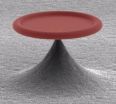"The strength and specificity of this receptor's effects indicate that it could be a very important target," said Calvin Kuo, MD, PhD, associate professor of medicine. "It's really a spectacular phenotype. For a stroke, we might want to stimulate the function of this receptor; for a brain tumor, we might want to inhibit it."
Kuo is the senior author of the research, which will be published Nov. 12 in Science. Frank Kuhnert, PhD, a research associate in the Kuo lab, is the first author of the work. The research was supported in part by the Stanford Center for Children's Brain Tumors.
The protein, called GPR124, is a member of a family of proteins called G-protein-coupled receptors that span the cellular membrane. Each receptor has a protein partner called a ligand that is secreted into the extracellular space — usually by a different cell. When a ligand binds to its receptor, it causes a cascade of events within that cell. In this way, the secreted ligand allows cells to "talk" to one another across distances to coordinate many aspects of development and metabolism.
There are hundreds of different G-protein-coupled receptors, and the functions of many have been identified. GPR124, however, is relatively unusual in that an exceptionally large portion of the protein projects out of the membrane into the extracellular space. Kuo and his colleagues, who study how tumors recruit blood vessels to nourish and sustain them, were drawn to it because it has previously been shown to be involved in tumor blood vessels, though nobody knew specifically what it did.
The researchers began by looking to see where in an adult mouse the receptor was normally expressed. They discovered that it is found almost exclusively on the endothelial cells of the brain and the central nervous system. (Endothelial cells line blood vessels throughout the body and help blood to flow more smoothly.) When the researchers bred mice lacking the ability to express GPR124, they died as embryos after about 15 days of gestation. Looking at cross-sections of their brains, it was easy to see why.
"These embryos did not have any blood vessels entering their forebrains or developing spinal cords at all," said Kuo. "And the effects were very specific for the nervous system since all other organs had normal blood vessel development." The forebrain includes the cerebral cortex, which plays a key role in memory, attention, consciousness and thought. In contrast, control mice embryos, with normal expression of GPR124, began developing brain blood vessels by about 11.5 days.
Interestingly, the researchers noticed that the timing of vessel development coincided with the formation of a physiological security checkpoint called the blood-brain barrier. The barrier, which is due in part to particularly tight junctions between individual epithelial cells in blood vessels in the central nervous system, ensures that only select molecules such as oxygen and glucose have access to the brain, and bars the entry of bacteria or larger molecules. Unfortunately, it can also block the entry of essential drugs to treat cancer or stroke, and in some diseases, such as multiple sclerosis, it inappropriately admits self-reactive immune cells that attack brain tissue.
To investigate the coincidence, Kuo and Kuhnert teamed up with graduate student Michael Mancuso to show that GPR124 expression is required in endothelial cells to regulate expression of a protein called Glut1 known to be involved in the development of the blood-brain barrier. The results suggest that GPR124 also plays a role in barrier development.
Kuo and Kuhnert next overexpressed GPR124 in the mice and followed their development. While the mice at first seemed normal, they began to develop large tangles of blood vessels in their forebrains as they aged. After about one year, nearly 70 percent of the mice displayed this kind of abnormal hypervasculature — but only in their brains. The results show that the action of GPR124 is highly specific for the central nervous system.
Still, the identity of the receptor's ligand remains a mystery. Kuo and his colleagues teamed up with researchers from Stanford's School of Engineering to narrow down the options. They used a microfluidic chamber — a technique that, among other things, allows the analysis of single-cell behavior — specially constructed by graduate student Amir Shamloo to investigate how mouse endothelial cells expressing GPR124 reacted to cells from different parts of the brain. Shamloo works in the lab of Sarah Heilshorn, PhD, assistant professor in materials science and engineering.
The researchers placed the cells in the middle of the chamber, and filled the channels on either side with these extracts from the forebrain — where the receptor's effects seem to be concentrated — or the hindbrain, where the receptor is not essential. They found that the endothelial cells only migrated toward the extract from the forebrain, much like the blood vessels grow toward and penetrate the embryonic brain during development.
"This was a key turning point," Kuo said of the collaboration. "We struggled for years to model the action of this receptor in vitro, but we couldn't do it without these microfluidic chambers."
In the future, the researchers plan to use mice in which they can toggle the expression of GPR124 on and off at will to examine its role in brain tumor development and stroke. They also hope to learn more about whether GPR124 is involved in the formation of the blood-brain barrier.
"There are a tremendous number of disorders that could be affected by GPR124 expression," said Kuo. "We're excited to begin those studies."
###
Other Stanford researchers involved in the study include graduate student Hsiao-Ting, undergraduate Vir Choksi and postdoctoral scholar Mareike Florek, PhD. Additional funding for the research came from the National Institutes of Health, American Heart Association, UK Medical Research Council, Brain Tumor Society and Goldhirsh Foundation. Information about the Departments of Medicine, of Mechanical Engineering and of Bioengineering, which also supported the research, is available at http://medicine.stanford.edu/, http://me.stanford.edu/ and http://bioengineering.stanford.edu/.
The Stanford University School of Medicine consistently ranks among the nation's top medical schools, integrating research, medical education, patient care and community service. For more news about the school, please visit http://mednews.stanford.edu. The medical school is part of Stanford Medicine, which includes Stanford Hospital & Clinics and Lucile Packard Children's Hospital. For information about all three, please visit http://stanfordmedicine.org/about/news.html.
END


